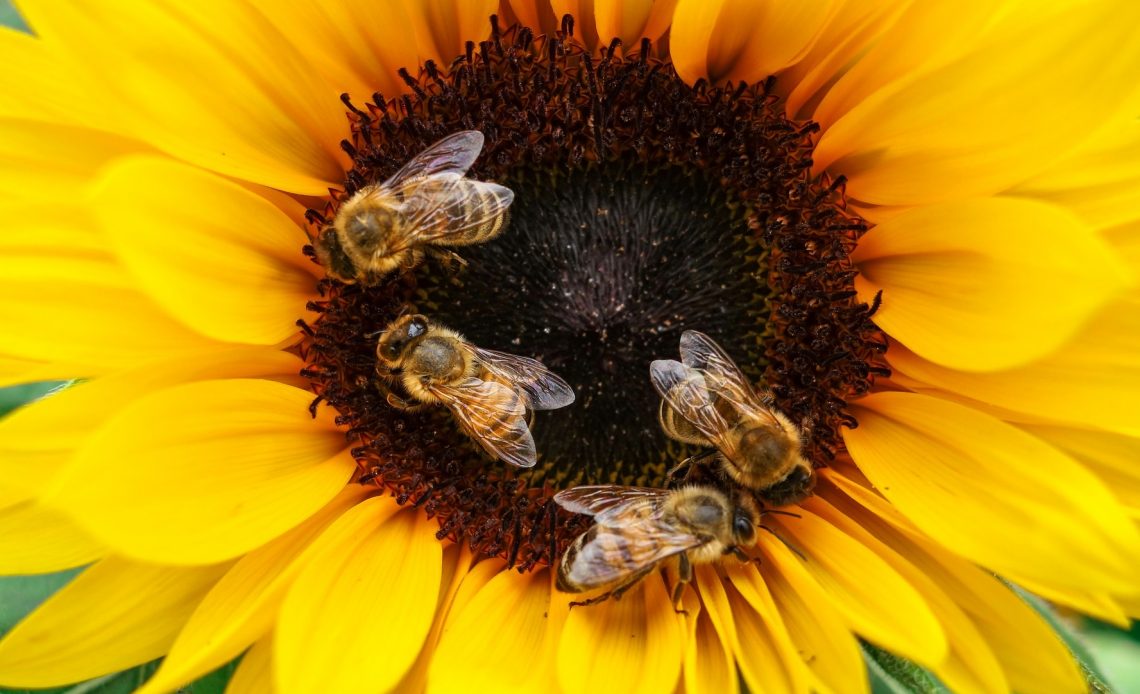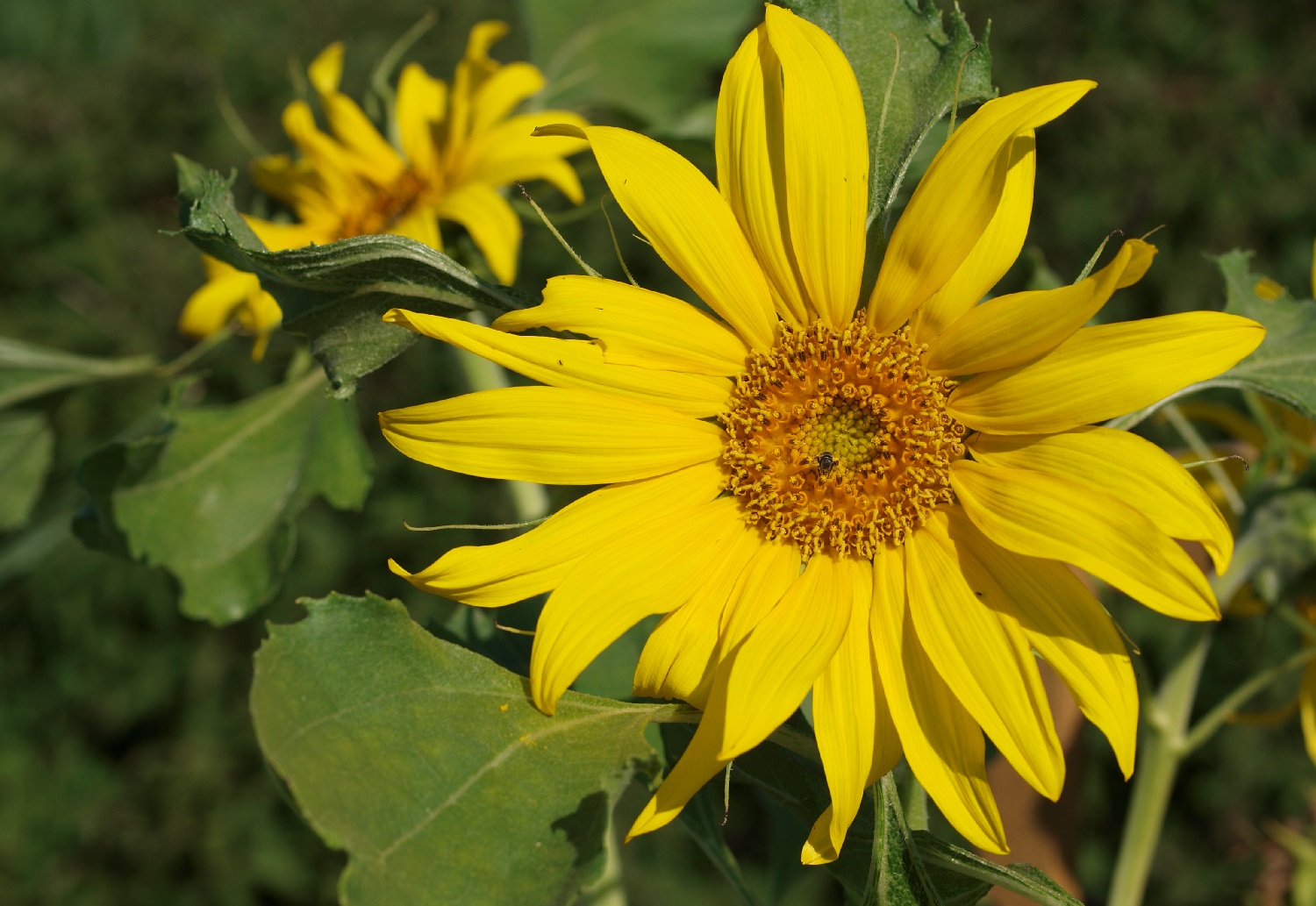

We’re here to help! Wild Yards is a completely free website that is 100% dedicated to helping you create a wildlife-friendly, sustainable yard. Read more
WildYards is reader-supported. When you buy a product through a link on our site, we may earn a comission. Every product is independently selected by our (obsessive) editors and our reviews are unbiased and objective. Read more about our mission or our privacy policy.
With their iconic bright yellow blooms, sunflowers are an attractive addition to any garden. But if you want to bring more pollinators to your wild yard, you may be wondering if sunflowers will do the trick. So, do bees like sunflowers?
Yes, they certainly do! Bees like sunflowers of all varieties, and they’re so easy to grow. In fact, sunflowers can be beneficial to your local hive’s health (more on that in a bit), which makes them an excellent choice for your backyard.
Why do bees like sunflowers?
A bee’s job is to pollinate and produce honey. In order to do this, they need a reliable source of pollen and nectar, and the sunflower has both of these things in abundance. Scientifically known as Helianthus annuus, common sunflowers are easily identified by their tall green stalks, and large yellow flowers with yellow, green, or brown centers.
Sunflowers are extremely fast-growing, usually developing buds within just two months of planting. The flowerheads reach 12-inches in diameter, giving multiple bees plenty of space to pollinate and feed at the same time.
These large, showy flowers are long-lasting, blooming for six to twelve weeks, which helps satisfy the bee’s near-constant need for sustenance. Each bloom emits a strong, sweet scent that attracts bees (and butterflies, too, for that matter) from miles away. This fragrance tells the bees that the sunflowers are full of nectar, which, once ingested, can be used to produce honey later on back at the hive.
Which sunflowers do bees like best?
Bees like all sunflowers, but especially common sunflowers. When it comes to choosing bee-friendly sunflowers, classic varieties such as ‘Yellow Pygmy’, ‘Mammoth Grey Stripe’, and ‘Lemon Queen’, are all great options. As a rule of thumb, you really can’t go wrong when you choose from traditional yellow sunflower species, as these types of sunflowers are among some of the best flowers for attracting bees to your backyard.

Even though the deep red ‘Moulin Rouge’ or the gentle pink ‘Iris Tectorum Rose’ may not be your neighborhood bees’ first choice, they can still enjoy them when placed with traditional sunflowers. But, when given a choice, always choose the traditional yellow sunflowers that bees like best.
Hybrid flowers tend to be less fragrant than traditional varieties. So sunflowers that have been cultivated to produce blue, red, or other colored blooms may not be as effective at attracting bees as traditional species. That said, it is worth noting that these hybrid sunflowers can still attract bees in the right setting.
Which sunflowers are best for attracting bees?
For large backyard spaces, think big! Opt for the taller sunflower varieties, like ‘Russian Mammoth’ and ‘American Giant’. These eye-catching flowers reach impressive heights of 12 to 16 feet, making them a great focal point for your yard. The taller the sunflower, the easier it is for bees to spot when they fly by.
For small gardens, choose dwarf sunflower varieties, such as ‘Cusick’s Sunflower’ or ‘Sungold Dwarf Sunflower’, which reach maximum heights of two and three feet, respectively. These sunflowers are ideal for container gardening because they require minimal space. Not only do these smaller sunflowers attract bees, but they also attract hummingbirds, as well as a variety of other birds when they go to seed. If you’ve got a little backyard, dwarf sunflowers are an incredibly effective choice for attracting a variety of wildlife!
What flowers should you plant with sunflowers to attract bees?
Sunflowers are just the thing you need to attract bees to your backyard space. But adding other flowers that bees enjoy encourages them to visit your garden frequently and to stay for longer periods of time. To keep your local bees’ attention, plant a variety of different flowers in your backyard.
Hydrangeas, especially lacecap and oakleaf varieties, are very popular with bees. When choosing hydrangeas to attract bees, opt for white and blue flowers. These blooms have higher visibility for bees, as they have difficulty seeing the color red.
Clematis is another excellent choice for bringing bees to your yard. ‘Diana’s Delight’ clematis vine features beautiful purple-blue flowers that attract many pollinating insects, including bees. And, because it’s a vine, it allows many pollinators to feed at one time. Hummingbirds are attracted to clematis, too, so this fragrant flower works overtime to bring a variety of wildlife to your outdoor space.
Where do bees like sunflowers to be planted?
Sunflowers need sun — it’s a part of their name, after all! But, as it turns out, where you put your sunflowers can have a great impact on whether or not they attract bees. Did you know that bees like sunflowers planted facing east? This is because sunflowers facing the rising sun capture heat better than those facing away from the sun, and bees (just like all the rest of us!) want to be comfortable when they’re eating.
Whether you grow sunflowers in the ground or in pots, make sure the spot you grow them in has the flowers facing east. Giving the bees a safe, inviting garden to buzz around in will keep them coming back for more!
Are sunflowers better for bees than other flowers?
The best bee garden is one that offers bees an assortment of blooms to visit because bees like variety. The more flowers that they have to browse, the longer they will stay in your garden, and the more frequently they’ll visit. Lots of flowers provide adequate nectar and plenty of pollen for bees. But sunflowers offer bees a unique health advantage because sunflower pollen is rich in vitamin E.
The immune system-enhancing effects of sunflower pollen help honeybees stave off fungal infections. Fewer fungal infections mean fewer bee deaths, which means more healthy drones to pollinate your garden. Over time, this has a trickle-up effect, systemically improving the health of the entire hive.
By planting sunflowers to attract bees to your backyard, you can provide them with a steady source of food. And, by keeping your neighborhood bees healthy with the help of nutritious sunflower pollen, you can improve the lives of these valuable pollinators, and support your local ecosystem!
